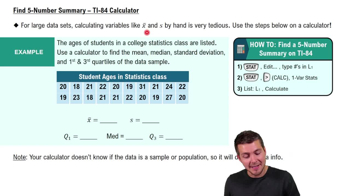Here are the essential concepts you must grasp in order to answer the question correctly.
Percentiles
Percentiles are measures that indicate the relative standing of a value within a dataset. Specifically, the nth percentile is the value below which n percent of the data falls. For example, the 25th percentile (Q1) is the value below which 25% of the observations lie, helping to understand the distribution of data points.
Quartiles
Quartiles are specific percentiles that divide a dataset into four equal parts. The first quartile (Q1) represents the 25th percentile, the second quartile (Q2) is the median or 50th percentile, and the third quartile (Q3) is the 75th percentile. Quartiles are useful for summarizing data and identifying the spread and center of a dataset.
Recommended video:
Find 5-Number Summary - TI-84 Calculator
Data Distribution
Data distribution refers to how values are spread or arranged in a dataset. Understanding the distribution is crucial for interpreting percentiles and quartiles, as it affects the calculation of these measures. A dataset can be normally distributed, skewed, or uniform, which influences the interpretation of statistical measures and the overall analysis.
Recommended video:
Visualizing Qualitative vs. Quantitative Data






